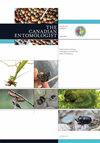加拿大安大略省和魁北克省油菜籽入侵害虫大腹小蛾(鞘翅目:小蛾科)的寄生蜂群落
IF 1.1
4区 农林科学
Q3 ENTOMOLOGY
引用次数: 14
摘要
摘要/ Abstract摘要:对加拿大安大略省和魁北克省油菜入侵害虫白菜籽荚象甲(Ceutorhynchus obstrictus, Marsham)的寄生群落进行了调查。在油菜籽上大量孳生的瘿蜂科昆虫超过18种(膜翅目)。在安大略省西南部,分布最丰富的种类为绿毛蝽1种(23.6% ~ 48.6%)、perdubius Lyrcus (Girault)(0% ~ 53%)、L. maculatus (Gahan)(2.8% ~ 14.7%)和瑞典斑蝽(Pteromalus Swederus)(0.6% ~ 23.1%)。在魁北克最丰富的种类是:斑点毛蝇(毛蝇)(飞蛾科)(33.3% ~ 56.4%)、未确定的毛蝇科(2.1% ~ 39.1%)、斑点毛蝇(毛蝇科)(1.3% ~ 21.4%)和斑点毛蝇(毛蝇科)(11.5% ~ 19.3%)。在安大略省渥太华地区,寄生蜂于2008年首次被发现,其中以完美毛蝇(斑点毛蝇科)、墨氏毛蝇和斑点毛蝇最常见。在北美首次报道了gemellus和perfect T.。虽然现有的群落似乎提供了大量的寄生(例如,2006年为6.3%-26.3%),但物种组成因年份而异,与北美其他地区不同。因此,应该监测白菜籽荚象鼻虫的寄生水平和寄生群落,以评估它们是否会增加,或者是否需要从欧洲引入更多可能带来更高死亡率的宿主特异性物种。本文章由计算机程序翻译,如有差异,请以英文原文为准。
The Parasitoid Communities Associated with An Invasive Canola Pest, Ceutorhynchus obstrictus (Coleoptera: Curculionidae), in Ontario and Quebec, Canada
Abstract
Surveys were conducted to determine the parasitoid communities associated with the cabbage seedpod weevil, Ceutorhynchus obstrictus (Marsham), an important invasive pest of canola in Ontario and Quebec, Canada. More than 18 species of Chalcidoidea (Hymenoptera) were associated with this pest through mass rearings from canola siliques. In southwestern Ontario, the most abundant species were a species of Chlorocytus Graham (23.6%–48.6%), Lyrcus perdubius (Girault) (0%–53%), L. maculatus (Gahan) (2.8%–14.7%), and species of Pteromalus Swederus (0.6%–23.1%) (Pteromalidae). In contrast, the most abundant species in Quebec were Trichomalus lucidus (Walker) (Pteromalidae) (33.3%–56.4%), unidentified Eulophidae (2.1%–39.1%), Mesopolobus gemellus Baur and Muller (Pteromalidae) (1.3%21.4%), and Necremnus tidius (Walker) (Eulophidae) (11.5%–19.3%). In the Ottawa, Ontario, area, parasitoids were first recovered in 2008, and Trichomalus perfectus (Walker) (Pteromalidae), M. gemellus, and species of Pteromalus were most prevalent. Mesopolobus gemellus and T. perfectus are reported in North America for the first time. Although existing communities appear to provide substantial parasitism (e.g., 6.3%–26.3% in 2006), species composition varies among years and differs from that in other regions in North America. Thus, parasitism levels and parasitoid communities of the cabbage seedpod weevil should be monitored to assess whether these will increase or there is a need to introduce more host-specific species from Europe that could provide greater mortality.
求助全文
通过发布文献求助,成功后即可免费获取论文全文。
去求助
来源期刊

Canadian Entomologist
生物-昆虫学
CiteScore
2.20
自引率
11.10%
发文量
24
审稿时长
6-12 weeks
期刊介绍:
French translation follows/le français suit Published since 1868, this peer-reviewed bimonthly publication is the official journal of the Entomological Society of Canada. Available via the internet and with hardcopy distribution to 55 countries, its research papers and notes are relevant to entomologists and other biologists around the world. In addition to being a venue for topical reviews and forum discussion, The Canadian Entomologist publishes current research in all facets of entomology, including systematics and morphology, molecular and developmental biology, ecology and behaviour, biodiversity and evolution, insect management, entomological techniques, and other relevant subject areas. Contributions are published in English or French. Authors will not pay page charges, and will experience fast, high quality reviews of their papers.Publiée depuis 1868, cette publication bimestrielle avec comité de lecture est la revue officielle de la Société d’entomologie du Canada. Disponible sur Internet et distribuée en format papier dans 55 pays, ses articles de recherche et ses notes sont pertinents pour les entomologistes et autres biologistes de par le monde. En plus d’être une plate-forme pour des revues thématiques et un forum de discussion, The Canadian Entomologist publie la recherche actuelle sur toutes les facettes de l’entomologie, incluant la systématique et la morphologie, la biologie moléculaire et développementale, l’écologie et le comportement, la biodiversité et l’évolution, la gestion des insectes, les techniques entomologiques et d’autres domaines pertinents. Les contributions sont publiées en français ou en anglais. Les auteurs ne paient aucun frais de publication, et recevront une révision rapide et de grande qualité de leurs articles.
 求助内容:
求助内容: 应助结果提醒方式:
应助结果提醒方式:


